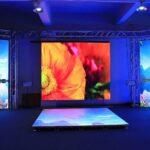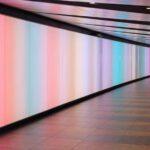Key Trends of outdoor LED displays
Did you know? According to the latest report from Grand View Research, the global outdoor LED display market is expected to continue to expand at a compound annual growth rate of 12.3%, and will exceed US$25 billion by 2030. As a core player in the field of LED Display, we have witnessed how technological iterations have reshaped urban landscapes, commercial communications, and public interactive experiences. Today, we will deeply analyze the top ten technological trends of outdoor LED screens to help you seize the industry opportunities.
1. Visual Revolution: 3D Outdoor LED Screen
Traditional print advertising can no longer satisfy brands’ pursuit of eyeball economy. The new generation of 3D outdoor LED screens use dynamic depth of field algorithms and naked-eye 3D technology to make the images jump out of the screen.
For example, the Transparent LED Screen in Shinjuku, Tokyo, combines architectural structures to create a floating advertising effect, increasing the interactive conversion rate by 37% (Source: Diginfo TV).
This type of technology is particularly suitable for high-end brands such as luxury goods and automobiles.
2. Data-driven: outdoor large screens and big data integration
Through built-in sensors and AI analysis, outdoor LED Display Screen is upgrading from one-way communication to a data hub.
For example, the Custom LED Screen in New York’s Times Square can capture crowd density in real time and dynamically adjust advertising content, increasing brand exposure efficiency by 22% (Source: Nielsen Outdoor Report).
3. Interaction upgrade: touch and AR technology empowerment
Users are no longer passive viewers. Equipped with infrared touch and AR overlay technology, Flexible LED Screen has been applied to shopping mall guides and event live broadcasts.
At the 2023 Munich Motor Show in Germany, visitors can use gestures to control the LED Screen Panel to disassemble car models, increasing their stay time by 40% (Source: EventMarketer).
4. Resolution transition: small pitch and 8K popularization
LED Displays with higher resolution (such as P1.2 fine pitch) are breaking the bottleneck of outdoor image quality.
The circular screen at the Sphere in Las Vegas has a resolution of 19,000×13,500, and its stunning effect has led to a 65% surge in customer traffic in the surrounding business district (Source: AV Magazine).
5. Green transformation: energy consumption reduced by 30%
Environmental protection policies promote technological innovation. Through intelligent brightness adjustment and COB packaging technology, the new generation of LED Outdoor Display reduces power consumption by 35% compared with traditional products and supports solar power supply.
After the renovation of a commercial area in Shenzhen, the annual electricity bill was saved by more than 1.2 million yuan (Source: LEDinside).
6. Maintenance innovation: Fully Front Accessible
Traditional Outdoor LED Screen maintenance requires disassembly of the entire module, which is time-consuming and costly. The full front maintenance technology allows the faulty module to be quickly replaced from the front, increasing maintenance efficiency by 50%, which is especially suitable for Rent a LED Screen scenarios.
7. Lightweight design: 40% weight reduction
The application of magnesium alloy frame and nano materials reduces the weight of LED Screen Panel to below 18kg/㎡.
The lightweight design not only reduces transportation costs, but also expands installation scenarios such as glass curtain walls and temporary stages.
8. Fanless operation: lifespan extended to 100,000 hours
Traditional cooling fans are prone to dust accumulation and failure. Fan-less LED Display conducts heat through a vapor chamber, reducing noise to below 20dB, and the MTBF (mean time between failures) exceeds 100,000 hours, making it suitable for static-sensitive scenes such as hospitals and museums.
9. Environmental adaptability: IP68 protection and -40℃~60℃ wide temperature range
LED Display China has performed well in extreme environments. Harbin Ice and Snow World’s outdoor LED screen has been running at -35°C for three years without any problems, proving the reliability of domestic technology.
10. Cost optimization: operation and maintenance costs reduced by 50%
From remote diagnosis to modular spare parts, the intelligent operation and maintenance system reduces the fault response time of LED Displays to 2 hours and reduces the full life cycle cost by 50%.
A hotel in Dubai saved $280,000 in annual maintenance budget through predictive maintenance (Source: AVIXA)
If you’re planning an outdoor advertising upgrade, event planning, or smart city project, these trends will directly impact your ROI.
As a Chinese manufacturer with more than 10 years of experience in the LED Display industry, we provide one-stop services from transparent screens, flexible screens to customized solutions. Click to follow us and stay on top of the latest technology!

